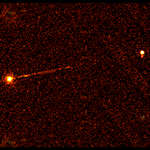Imagine the Universe News - 12 June 2000
Chandra Reveals Cosmic 'Hot Spot'
| 12 June 2000 |
|
When you look at the image at left, what do you see? Two bright spots and a streak? That's exactly what it is, but it's also much more than that. The image, captured by NASA's Chandra X-ray Observatory, shows a spectacular jet of x-rays streaking across hundreds of thousands of light years. The jet is powered by a giant black hole in the center of the galaxy, Pictor A. The stream of radiation ends in a brilliant x-ray hot spot.
The hot spot is at least 800 thousand light-years (about eight times the diameter of our Milky Way galaxy) away from the source of the radiation jet. Scientist believe the hot spot is the advancing head of the jet, which brightens dramatically where it plows into the thin gas of intergalactic space. The jet originates from a region of space no bigger than the solar system.
Such jets are thought to be produced by the extreme electromagnetic forces created by magnetized gas swirling toward a black hole. Although most of the material falls into the black hole, some can be ejected at extremely high speeds. Magnetic fields created by these forces can extend over vast distances and may help explain the narrowness of the jet.
"Both the brightness and the spectrum of the X-rays are very different from what theory predicts," Professor Andrew Wilson recently reported at the meeting of the American Astronomical Society in Rochester, New York. Professor Wilson, Dr. Patrick Shopbell and Dr. Andrew Young, all of the University of Maryland, are submitting an article on this research to the Astrophysical Journal. "The Chandra observations are telling us that something out there is producing many more high-energy particles than we expected," professor Wilson said.
Scientist don't fully understand the unusual X-ray hot spot. The radiation may create shock waves as it streams through space. These shock waves may be accelerating electrons and possibly protons to incredibly high energies, and velocities nearing the speed of light. These electrons produce X-rays as they rapidly lose that energy. This could be the first direct evidence of this process so far outside a galaxy.

Artist rendition of the Chandra X-ray Observatory in orbit |
The Chandra observation of Pictor A was made on January 18, 2000 for eight hours using the Advanced CCD Imaging Spectrometer (ACIS). Scientist using radio telescopes have seen the hot spot and jet as well. So far, optical telescopes have only seen the hot spot.
The ACIS instrument was built for NASA by the Massachusetts Institute of Technology, Cambridge, and Pennsylvania State University, University Park. NASA's Marshall Space Flight Center in Huntsville, AL, manages the Chandra program. The Smithsonian's Chandra X-ray Center controls science and flight operations from Cambridge, MA.


